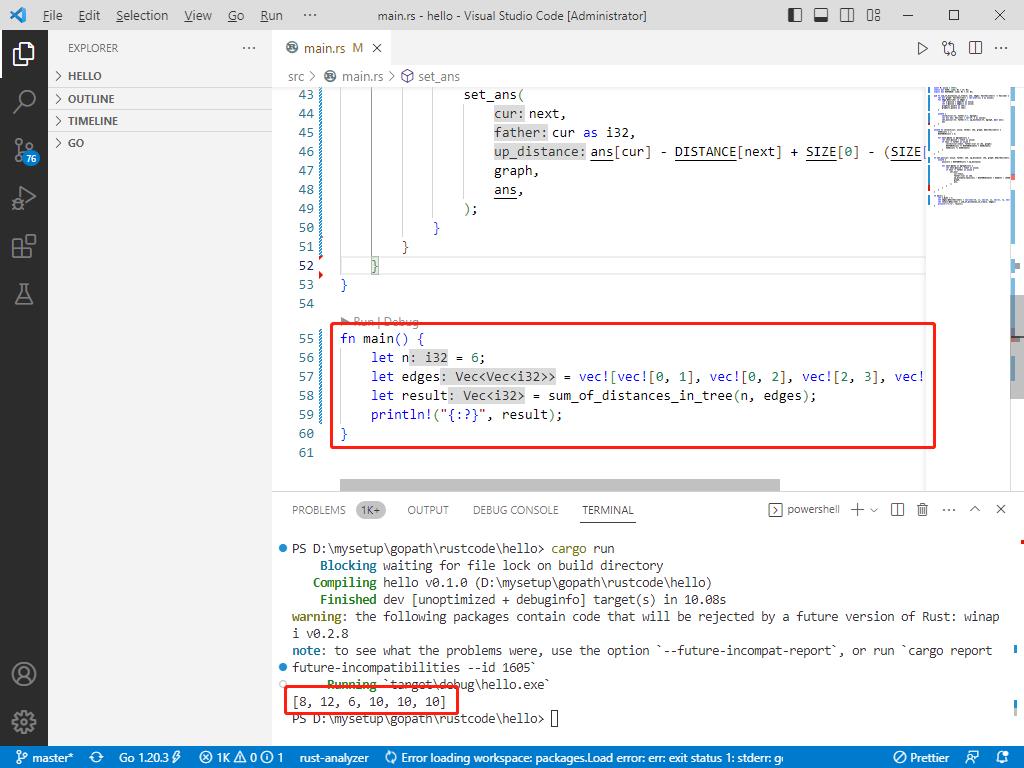2023-05-05:给定一个无向连通的树 树中有 n 个标记为 0...n-1 的节点以及 n-1 条边 。 给定整数 n 和数组 edges , edges[i] = [ai, bi]表示树中的
Posted 在等月亮和你
tags:
篇首语:本文由小常识网(cha138.com)小编为大家整理,主要介绍了2023-05-05:给定一个无向连通的树 树中有 n 个标记为 0...n-1 的节点以及 n-1 条边 。 给定整数 n 和数组 edges , edges[i] = [ai, bi]表示树中的相关的知识,希望对你有一定的参考价值。
2023-05-05:给定一个无向、连通的树
树中有 n 个标记为 0...n-1 的节点以及 n-1 条边 。
给定整数 n 和数组 edges ,
edges[i] = [ai, bi]表示树中的节点 ai 和 bi 之间有一条边。
返回长度为 n 的数组 answer ,其中 answer[i] :
树中第 i 个节点与所有其他节点之间的距离之和。
输入: n = 6, edges = [[0,1],[0,2],[2,3],[2,4],[2,5]]。
输出: [8,12,6,10,10,10]。
答案2023-05-05:
思路:
给定一棵无向、连通的树,要求计算每个节点到其他所有节点的距离之和。
可以通过遍历树,对于每个节点分别计算它到其他节点的距离之和。对于每个节点,利用它的子节点信息来更新它到其他节点的距离之和,然后递归地更新它的子节点。最终得到所有节点的距离之和。
具体实现如下:
1.构造图
通过给定的 edges 数组构造无向图。
2.遍历树,计算每个节点到其他节点的距离之和
从根节点开始递归遍历树,对于每个节点,首先初始化它到其他节点的距离之和为 0,然后递归地处理它的子节点。处理完所有子节点之后,计算该节点到其他节点的距离之和,并将该节点的大小(即包括自身在内的节点数)保存下来。
3.递归更新节点到其他节点的距离之和
从根节点开始递归遍历树,对于每个节点,首先计算它到其他节点的距离之和,并将其保存在 ans 数组中。然后递归地处理它的子节点,将它们对应的距离之和更新到 upDistance 中,并计算每个子节点到其他节点的距离之和。
总时间复杂度:O(n)
总空间复杂度:O(n)
go完整代码如下:
package main
import "fmt"
var N int = 30001
var size [30001]int
var distance [30001]int
func sumOfDistancesInTree(n int, edges [][]int) []int
graph := make([][]int, n)
for i := range graph
graph[i] = []int
for _, edge := range edges
u := edge[0]
v := edge[1]
graph[u] = append(graph[u], v)
graph[v] = append(graph[v], u)
collect(0, -1, graph)
ans := make([]int, n)
setAns(0, -1, 0, graph, ans)
return ans
func collect(cur int, father int, graph [][]int)
size[cur] = 1
distance[cur] = 0
for _, next := range graph[cur]
if next != father
collect(next, cur, graph)
distance[cur] += distance[next] + size[next]
size[cur] += size[next]
func setAns(cur int, father int, upDistance int, graph [][]int, ans []int)
ans[cur] = distance[cur] + upDistance
for _, next := range graph[cur]
if next != father
setAns(
next,
cur,
ans[cur]-distance[next]+size[0]-(size[next]<<1),
graph,
ans,
)
func main()
n := 6
edges := [][]int0, 1, 0, 2, 2, 3, 2, 4, 2, 5
result := sumOfDistancesInTree(n, edges)
fmt.Println(result)

rust完整代码如下:
const N: usize = 30001;
static mut SIZE: [i32; N] = [0; N];
static mut DISTANCE: [i32; N] = [0; N];
pub fn sum_of_distances_in_tree(n: i32, edges: Vec<Vec<i32>>) -> Vec<i32>
let mut graph: Vec<Vec<i32>> = vec![vec![]; n as usize];
for edge in edges
let u = edge[0] as usize;
let v = edge[1] as usize;
graph[u].push(v as i32);
graph[v].push(u as i32);
unsafe
collect(0, -1, &graph);
let mut ans: Vec<i32> = vec![0; n as usize];
set_ans(0, -1, 0, &graph, &mut ans);
ans
unsafe fn collect(cur: usize, father: i32, graph: &Vec<Vec<i32>>)
SIZE[cur] = 1;
DISTANCE[cur] = 0;
for next in &graph[cur]
let next = *next as usize;
if next != father as usize
collect(next, cur as i32, graph);
DISTANCE[cur] += DISTANCE[next] + SIZE[next];
SIZE[cur] += SIZE[next];
fn set_ans(cur: usize, father: i32, up_distance: i32, graph: &Vec<Vec<i32>>, ans: &mut Vec<i32>)
unsafe
ans[cur] = DISTANCE[cur] + up_distance;
for next in &graph[cur]
let next = *next as usize;
if next != father as usize
set_ans(
next,
cur as i32,
ans[cur] - DISTANCE[next] + SIZE[0] - (SIZE[next] << 1),
graph,
ans,
);
fn main()
let n = 6;
let edges = vec![vec![0, 1], vec![0, 2], vec![2, 3], vec![2, 4], vec![2, 5]];
let result = sum_of_distances_in_tree(n, edges);
println!(":?", result);

c完整代码如下:
#include <stdio.h>
#include <stdlib.h>
#define N 30001
int size[N];
int distance[N];
void collect(int cur, int father, int** graph, int n);
void setAns(int cur, int father, int upDistance, int** graph, int* ans);
int* sumOfDistancesInTree(int n, int edges[][2])
int** graph = malloc(n * sizeof(*graph));
for (int i = 0; i < n; i++)
graph[i] = malloc((n + 1) * sizeof(**graph));
for (int j = 0; j <= n; j++)
graph[i][j] = -1;
for (int i = 0; i < n - 1; i++)
int u = edges[i][0];
int v = edges[i][1];
if (graph[u][0] == -1)
graph[u][0] = 0;
if (graph[v][0] == -1)
graph[v][0] = 0;
int j = 0;
while (graph[u][++j] != -1);
graph[u][j] = v;
j = 0;
while (graph[v][++j] != -1);
graph[v][j] = u;
collect(0, -1, graph, n);
int* ans = malloc(n * sizeof(int));
setAns(0, -1, 0, graph, ans);
for (int i = 0; i < n; i++)
free(graph[i]);
free(graph);
return ans;
void collect(int cur, int father, int** graph, int n)
size[cur] = 1;
distance[cur] = 0;
int j = 1;
while (graph[cur][j] != -1)
int next = graph[cur][j];
if (next != father)
collect(next, cur, graph, n);
distance[cur] += distance[next] + size[next];
size[cur] += size[next];
j++;
void setAns(int cur, int father, int upDistance, int** graph, int* ans)
ans[cur] = distance[cur] + upDistance;
int j = 1;
while (graph[cur][j] != -1)
int next = graph[cur][j];
if (next != father)
setAns(
next,
cur,
ans[cur] - distance[next] + size[0] - (size[next] << 1),
graph,
ans
);
j++;
int main()
int n = 6;
int edges[][2] = 0, 1, 0, 2, 2, 3, 2, 4, 2, 5 ;
int* result = sumOfDistancesInTree(n, edges);
for (int i = 0; i < n; i++)
printf("%d ", result[i]);
printf("\\n");
free(result);
return 0;

c++完整代码如下:
#include <iostream>
#include <vector>
//using namespace std;
const int N = 30001;
static int size[N];
static int distance[N];
void collect(int cur, int father, std::vector<std::vector<int>>& graph);
void setAns(int cur, int father, int upDistance, std::vector<std::vector<int>>& graph, int* ans);
int* sumOfDistancesInTree(int n, std::vector<std::vector<int>>& edges)
std::vector<std::vector<int>> graph(n);
for (auto edge : edges)
int u = edge[0];
int v = edge[1];
graph[u].push_back(v);
graph[v].push_back(u);
collect(0, -1, graph);
int* ans = new int[n];
setAns(0, -1, 0, graph, ans);
return ans;
void collect(int cur, int father, std::vector<std::vector<int>>& graph)
size[cur] = 1;
distance[cur] = 0;
for (auto next : graph[cur])
if (next != father)
collect(next, cur, graph);
distance[cur] += distance[next] + size[next];
size[cur] += size[next];
void setAns(int cur, int father, int upDistance, std::vector<std::vector<int>>& graph, int* ans)
int a = N;
ans[cur] = distance[cur] + upDistance;
for (auto next : graph[cur])
if (next != father)
setAns(
next,
cur,
ans[cur] - distance[next] + size[0] - (size[next] << 1),
graph,
ans
);
int main()
int n = 6;
std::vector<std::vector<int>> edges = 0, 1, 0, 2, 2, 3, 2, 4, 2, 5 ;
int* result = sumOfDistancesInTree(n, edges);
for (int i = 0; i < n; i++)
std::cout << result[i] << " ";
std::cout << std::endl;
delete[] result;
return 0;

随机森林 - 使空值始终在决策树中有自己的分支
【中文标题】随机森林 - 使空值始终在决策树中有自己的分支【英文标题】:Random Forest - make null values always have their own branch in a decision tree 【发布时间】:2020-03-17 04:32:27 【问题描述】:您好,我正在使用随机森林来构建模型,并且正在尝试处理空值。有人会碰巧知道如何强制随机森林模型将空值视为自己的独立带吗? (因为空值永远不会与其他值范围捆绑在一起。因此在决策树中,度量的空值总是有自己的分支)。
我不想使用均值代替空值,因为我不希望模型将空值与接近均值的其他值结合起来,我也不想删除空值。
我希望决策树始终将度量的空值视为自己的分支。
谢谢:)
【问题讨论】:
【参考方案1】:你可以试试这些。
-
将空值替换为与列中的任何其他值有很大差异的值。
示例
让 'feature' 是只有正值的列的名称,那么负值应该足以表示 null。
dataframe.loc[dataframe['feature'].isna(), 'feature'] = -100
-
您可以添加一个新的空跟踪列来跟踪另一列的空值。 (如果所有特征都被考虑用于对随机森林进行建模,则使用此选项)
示例
让 'feature' 为具有空值的列的名称
dataframe['feature_isnull'] = 0 #null-tracking column
dataframe.loc[dataframe['feature'].isna(),'feature_isnull'] = 1
【讨论】:
以上是关于2023-05-05:给定一个无向连通的树 树中有 n 个标记为 0...n-1 的节点以及 n-1 条边 。 给定整数 n 和数组 edges , edges[i] = [ai, bi]表示树中的的主要内容,如果未能解决你的问题,请参考以下文章